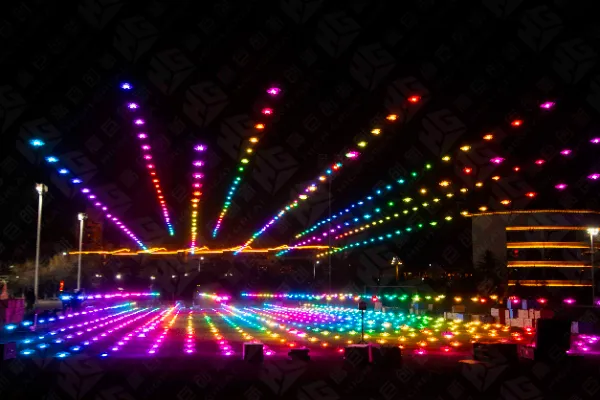Daily Maintenance of Outdoor Formation Lighted Drone
The advent of drone technology has impacted the way we view aerial activities, and the use of lighted drones in outdoor formations has become increasingly popular for entertainment, advertising, and special events. These drones are equipped with colored lights and synchronized movements, creating mesmerizing displays that captivate audiences. In this blog post, HighGreat will share with you the basic aspects of daily maintenance of outdoor formation lighted drone for sale to keep them in top condition.
Understanding the Components
Before diving into the maintenance routine, it's important to understand the key components of a lighted drone:
1. Frame and Body: The structural integrity of the drone.
2. Propellers: Essential for flight and maneuverability.
3. Motors and ESCs (Electronic Speed Controllers): Power the propellers and control their speed.
4. Battery: The energy source for the drone.
5. Lighting System: Consists of LEDs or other light sources for illumination.
6. Flight Controller: The brain of the drone, managing flight data and commands.
7. Communication System: For remote control and GPS signals.
8. Sensors: For altitude, orientation, and obstacle detection.
Pre-Flight Checks
Every day before the drone takes to the sky, a series of pre-flight checks should be conducted:
1. Visual Inspection: Look for any visible damage or wear on the drone's body, propellers, and other components.
2. Propeller Integrity: Ensure all propellers are secure and undamaged.
3. Battery Health: Check the battery for any signs of swelling, damage, or corrosion.
4. Lighting System: Confirm that all lights are functioning and not damaged.
5. Motor and ESC Function: Spin the motors by hand to ensure they are free of obstructions and can rotate smoothly.
6. Flight Controller: Verify that the flight controller is responding correctly to inputs.
7. Communication and Sensors: Test the remote control and GPS functionality.
Battery Care
Batteries are a critical component of drones, and their care is paramount:
1. Charge Regularly: Even if not in use, batteries should be charged regularly to maintain their health.
2. Avoid Overcharging: Follow the manufacturer's guidelines for charging times to avoid battery degradation.
3. Storage Conditions: Store batteries in a cool, dry place, and avoid extreme temperatures.
4. Balance Charging: Use a balance charger to ensure all cells in the battery are charged evenly.

Cleaning and Dust Removal
Drones can accumulate dust and debris, which can affect performance:
1. Soft Brush: Use a soft brush to gently remove dust from the drone's body and components.
2. Alcohol Wipes: For stubborn dirt, use isopropyl alcohol wipes to clean sensitive parts.
3. Avoid Water: Do not use water to clean the drone, as it can damage electronic components.
Software Updates
Keeping the drone's software up to date is essential for optimal performance:
1. Firmware Updates: Regularly check for and install firmware updates from the manufacturer.
2. App Updates: Ensure the controlling app is updated for the best user experience and compatibility.
Propeller Maintenance
Propellers are subject to wear and tear and should be replaced regularly:
1. Inspect for Damage: Look for cracks, bends, or other damage that could affect flight.
2. Balance: Ensure propellers are balanced to avoid vibrations and uneven flight.
3. Replacement: Replace propellers according to the manufacturer's recommendations or as needed.
Motor and ESC Maintenance
The motors and ESCs require regular attention to ensure they operate efficiently:
1. Check for Overheating: Overheating can damage motors and ESCs; allow them to cool down after use.
2. Lubricate: Apply a small amount of lubricant to the motor bearings if necessary.
3. ESC Calibration: Periodically calibrate the ESCs to ensure they are responding correctly to throttle inputs.
Lighting System Maintenance
The lighting system is what makes formation lighted drones stand out:
1. Inspect LEDs: Check for any burnt-out or malfunctioning LEDs.
2. Clean Lenses: Use a microfiber cloth to clean the lenses of the lights to ensure brightness is not reduced by dirt.
3. Check Wiring: Ensure all wiring is secure and free from damage.

Sensor Calibration
Accurate sensor readings are crucial for safe and precise flight:
1. Calibrate Gyroscope: Regularly calibrate the gyroscope for accurate orientation data.
2. Check for Obstruction: Make sure sensors are not obstructed by dust or debris.
3. Test Sensor Functionality: Perform test flights to ensure sensors are responding correctly.
Flight Practice and Patterns
Regular flight practice is essential to maintain the drone's performance and the pilot's skills:
1. Routine Flights: Conduct routine flights to check the drone's performance and responsiveness.
2. Pattern Drills: Practice formation patterns to ensure synchronization and coordination.
3. Emergency Procedures: Familiarize yourself with emergency procedures to handle unexpected situations.
Storage and Transportation
Proper storage and transportation are important to protect the drone:
1. Secure Storage: Store drones in a secure, padded case to protect them from damage.
2. Avoid Extremes: Do not expose drones to extreme temperatures or direct sunlight for extended periods.
3. Transport Safely: When transporting, ensure the drone is secure and all components are in place.
Conclusion
Daily maintenance of outdoor formation lighted drones is a comprehensive task that requires attention to detail and a systematic approach. By following the steps outlined in this blog post, you can ensure that your drones are ready for every performance, providing a seamless and breathtaking experience for your audience. Remember, the key to successful drone operation lies in regular care and upkeep.

 Telephone No.Email
Telephone No.EmailMailbox number:marketing@hg-fly.com



